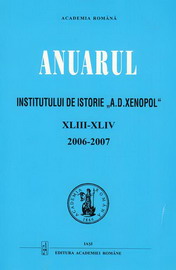Instrucţia tinerilor în şcolile greceşti din România (1860-1905)
Youth's Educattion in Greek Schools of Romania (1860-1905)
Author(s): Leonidas RadosSubject(s): History
Published by: Editura Academiei Române
Keywords: Greek schools; youth's instruction
Summary/Abstract: This study undertakes to clarify at least part of the sundry aspects regarding the Greek schools of Romania and youth's instruction in these institutions between two essential dates: 1860 (the recognition of Hellenic communities by Al. I. Cuza) and 1905, year in which, against the background of the cooling bilateral relations with Greece, Romania denounced the Romanian- Hellenic Commercial Convention (and of the ancillary Protocol) entered into 5 years before, fact which had the most serious consequences on the educational Greek institutions on the Romanian territory. There is not doubt that Greek schools of Romania were institutions designed mostly starting with the 9th-10th decades for the education of the children of the Greeks settled provisionally or permanently in the Romanian space. The cases of students of other nationalities (Jewish, Bulgarians, Romanians etc.) are rare and irrelevant. Moreover, the school curriculum of these children was the public school curriculum used in the Hellenic kingdom, and most teachers and school handbooks came from there too. The success of a school depended directly on the number of Greeks of that locality, which is worth considering, especially as at the end of the 19th century, the last important waves of Hellenic immigration in Danubian cities are reported. Therefore, the most renowned schools were set up in Bucharest, Galati and Braila, where the Hellenic community was best represented numerically. We see in Galati, especially at the “Venieris” Institute, at that of Denis Pylarinos and at that run by Aglaia Levidi-Pylarinou, at Braila the “Progresul” Hellenic Institute and the “Dimoloulou” Institutes, and at Bucharest, even the school of the Hellenic community. These educational establishments adapt unevenly to the Romanian environment and to the requirements of a modern education, as authorities increase their control over them. Hence, it was clearly seen in 1905 that Hellenic schools were merely institutions tolerated by the Romanian state, often considered by the responsible of the specialized ministries as being detrimental to the autochtonous education, after the Romanian public educational system succeeded in getting better organized and in connecting to the European circuits. In 1905, against the background of some acute political bilateral differences, against Greek schools there is an offensive managed by the Ministry of Education of the time that aimed, on the one hand, to stop the Hellenic propaganda met here and the education, at least of the Romanian citizens’ children, to love their new country, Romania, and, on the other hand, it aimed to tailor the Hellenic Governments’ attitude in the Macedonian issue. Therefore, the pressure on schools was, under these circumstances, an ideological purification tool and a foreign-policy supporting tool.
Journal: Anuarul Institutului de Istorie »A.D. Xenopol« - Iaşi
- Issue Year: 2006
- Issue No: 43+44
- Page Range: 223-252
- Page Count: 29
- Language: Romanian

